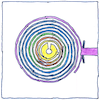Robert Hooke
horology

|
Hooke’s law
Robert Hooke invented the balance spring for watches and formulated the physical principle on which it depends. This principle is also known as the law of elasticity. The force you apply to compress or extend a spring is proportional to the distance you move it.
Hooke’s interests
Robert Hooke was Surveyor to the City of London, and chief assistant to Christopher Wren. He was Curator of Experiments for forty years for the Royal Society of London so was responsible for demonstrating and given opportunity for extending the ideas of other scientists. His interests and expertise ranged widely— astronomy, physics, optics, mechanics, horology, surveying, architecture, acoustics, geology, paleontology, microscopy, biology, and chemistry. Hooke created a theory of gravity and planetary motion, tried to measure the distance to a star using parallax, drew the rings of Saturn and craters on the moon, discovered one of the first observed double-star systems, wrote about earthquakes and the deformation of rock, understood that fossils derived from once-living plants and animals, helped design the dome of Saint Paul’s Cathedral, discovered nodal patterns of vibrations on glass plates, invented the anchor escapement and the balance spring, discovered that plants have cells, improved the vacuum pump, understood that combustion requires a component in air, and developed a complete and modern theory of memory.
The balance spring
Christiaan Huygens reinvented the balance spring fifteen years after Hooke. Hooke had shelved his work on clocks after finding he couldn’t make enough money for it. Hooke suggested that Newton look at ellipses for the motions of the planets but probably didn’t realize, as Newton did, the mathematical simplicity of gravity. In this age, science was too much a hobby of wealthy men. Hooke was a working man who could not afford to give his ideas away.



Robert Hooke deserves a place in this book for his invention of the balance spring in a watch and the anchor escapement, as well as for his formulation of the law of elasticity. Elsewhere, we give him credit for his discovery of the cell.
See also in The book of science:
Readings in wikipedia: